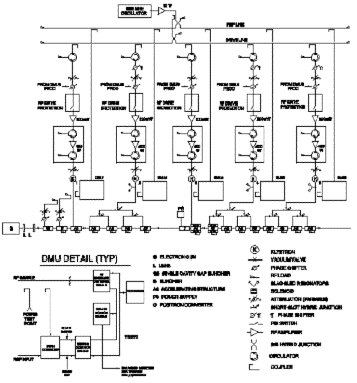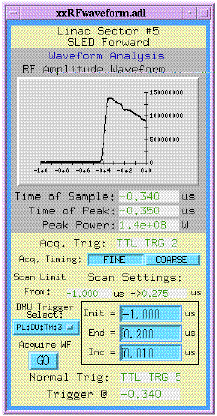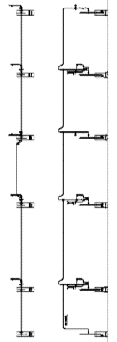A system of beam diagnostics and rf phase and amplitude measurement, based mostly on VXI, was implemented at the APS Linac and has now operated successfully for more than two years. Standardization of instrumentation among the various APS accelerators accounted for some of the non-VXI packaged equipment that was used. Equipment for which the optimum topology or location did not lend itself to VXI was also accommodated so as to yield the greatest stability, reliability, and flexibility.
The APS Linac instrumentation is described, and operational
performance is discussed. Future plans, including an expansion
to include a switchable spare klystron (which can be accommodated
with only minor changes to the VXI-housed equipment) and a beam
position monitor using frequency domain analysis to provide improved
determination of positron position in a mixed-particle beam condition
are also discussed.
The Advanced Photon Source [1] linear accelerator system consists of a 200-MeV, 2856-MHz S-band electron linac and a 2-radiation-thick tungsten target followed by a 450-MeV positron linac.
The VXI-based instrumentation includes rf phase and amplitude measurements and beam position monitors (BPMs), that use outboard down-conversion. Monitoring of beam current, Faraday cups, and slits is VME-based, following the APS standard. Loss monitors and average current monitors use other types of packaging. A fifth-harmonic cavity, used as a bunch monitor, was successfully tested but has not yet been set up for operational use.
Fluorescent screens and related image processing
constitute a separately controlled subsystem and are discussed
elsewhere [2,3].
The rf schematic for the APS linac is shown in Figure 1. Linac sectors are comprised of a klystron and associated accelerating structures. Three sectors incorporate SLED cavity pulse compression. The principal phase measurement is made at the SLED output or at the klystron output in sectors without SLEDs. Multiplexed phase measurements are available for other forward power samples, including at the input and output of each accelerating structure. Envelope detector channels are provided for almost all of these signals and for reflected power signals as well.
Each accelerating structure has its own loss monitor.

There are three wall-current monitors in the linac. Two are located in the electron linac and the third is at the end of the positron linac.
Six BPMs are installed in the electron linac, one
downstream of each accelerating structure and one in the diagnostic
line following the electron linac analyzing magnet. Seven BPMs
are installed in the positron linac, one downstream of six of
the last seven accelerating structures and one in the diagnostic
line following the positron linac analyzing magnet.
The VXI data collection modules were designed by
Los Alamos National Laboratory (LANL) [4] with upgrades accomplished
collaboratively by LANL and Argonne National Laboratory (ANL).
A common digital interface exists on all modules, while three
types of on-card signal conditioning allow measurements of rf
amplitude, rf phase, and beam position. Each channel digitizes
a single measurement during each linac pulse. Each module can
also be commanded by software to put analog signals onto either
or both sets of designated local bus lines on the backplane.Analog-to-digital
conversion in all modules is done by a Datel SHM-49 hybrid track/hold
amplifier and an AD574, 12bit, monolithic analog-to-digital
converter, yielding a 10-MHz bandwidth. The VXI data collection
and conversion modules used for each type of measurement are described
below.
Phase Measurement
A down converter module driving a vector
detector module (VDM) produces two channels of I and Q waveforms
and digital data. The VDM operates at 20 MHz and uses two insulated,
ovenized, I/Q demodulator assemblies. Phase is calculated by software
and can be plotted by on-line sweeping of the sampling time. A
phase between ñ180_
and +180_,
with a resolution of 0.01_,
is computed from measured I and Q data. The smaller in magnitude
of I and Q is always used as the numerator in the computation
to avoid losing precision near the sine wave maxima. Line-stretcher
type phase shifters are included at the reference inputs of each
sectorís phase measuring modules. These phase shifters
are set so that the phase reading of each sector can be set to
approximately +90_
at maximum energy conditions for electrons. There are two advantages
to this choice. +90_
is a point where phase is calculated as:

where I is near zero and the I channel has a lower
noise level than the Q channel. In addition, the readings for
electrons at +90_
and positrons at roughly ñ90_
will not fall near the point of discontinuous readings located
at ±
180_.
Amplitude Measurement
Envelope detector modules provide eight
channels of diode-detected signals. Linearized values for each
possible raw output value from the analog-to-digital converter,
interpolated from calibration of 88 points per channel, are stored
in an EEPROM.
Beam Position Monitor
A logarithmic amplifier electronics system
is used with stripline BPMs to measure electron and positron beam
positions at the APS linac. Stripline-type BPMs were chosen because
they provide ñ5 dBm of peak signal from the 8-mA positron
beam.
The electronics can be subdivided into two sections,
a downconverter section and a logarithmic amplifier section. Both
the external downconverter and the 70-MHz logarithmic amplifier
BPM VXI module have eight channels to accommodate two sets of
horizontal and vertical stripline signals. The downconverter section
consists of a 2.856 GHz-to-70 MHz downconverter followed by a
70MHz bandpass filter and amplifier. The bandpass filter
stretches the 30ns pulse to around 200 ns and reduces its
amplitude by some 13 dB. This 70MHz signal is used as the
input to a cascaded chain of logarithmic amplifiers consisting
of two Analog Devices AD640 with their video bandwidths set to
7 MHz. Beam position is calculated from the relative stripline
signal amplitudes. With the signal-to-noise ratio at the input
to the logarithmic amplifier circuits approaching 75 dB, resolutions
of 1 mm
should be possible [5].
Timing and Software Peak Detection
A different trigger timing system than
the one used at LANL is used for most measurements in the APS
linac and improves resolution and jitter by more than an order
of magnitude. The upgraded LANL modules allow any of the VXI backplane
triggers to be directly selected, or the LANL default triggering
system can still be used. A VXI trigger module, designed at ANL,
contains a set of eight-bit programmable delay lines that can
be used to select sample time in increments of 5 nanoseconds.
A separate delay line controls each of the two ECL triggers and
eight TTL triggers on the VXI backplane. Software peak detection
by scanning is available for all signals. Time scans are automated
and replace the hardware peak detecting circuits that are commonly
used. A typical SLED waveform time scan is shown in Figure 2.

Non-VXI Diagnostics
Wall current monitors are based on a design
previously used at Fermilab [6]. The signals from current monitors,
Faraday cups, and slits are processed with a VME-packaged, high-speed
gated integrator [7].The loss monitors use a design that is standard
throughout the APS, in which a 500-V power supply energizes a
7/8-inch air-dielectric coaxial cable that is used as an ionization
chamber. A signal processing chassis contains multiplexers, optical
isolators, and current-to-voltage amplifiers. A voltage proportional
to the average beam loss in the monitored accelerating structure
is digitized in a VME module [8].
The phase detection modules have achieved 0.1 degree average repeatability. Operating performance has supported closed-loop operation with as little as 0.5 degree dead zone.
Envelope detectors used in amplitude measurement have been repeatably calibrated to within 0.2 dB of a standard. Operational performance has been somewhat inconsistent, however, and errors of 0.5 dB have been reported. Some of this is due to trigger timing errors, and there is an ongoing effort to provide more specific timing for each signal.
Operational BPM resolution is acceptable at 53 mm,
and loss monitor sensitivity is at least 4.2 pA/pC with 0.3 s
minimum averaging time.
A system which will provide switching of a sixth klystron and modulator in place of any of the basic five is under design. Figure 3 is a layout of the most probable topology for accomplishing the switching. Additional waveguide bi-directional couplers are being added to the two sectors without SLEDs so that the principal phase measurement will be made at the input to each sector, independent of which klystron is actually driving that sector. SLEDed sectors are already compliant, as the measurements are made at the SLED output. As a result, only very minor changes to the phase measuring system will be required.
A new BPM system that gives information on the polarity
of the charged particle producing the signal (electron or positron)
has been developed, and will provide for much improved positron
diagnostics capability [9]. The new design takes advantage of
the fact that electrons and positrons have different phase relationships
between odd and even order frequency components by detecting I
and Q separately for fundamental and second harmonic components
of the stripline signals. A prototype is under development.
The instrumentation has supported the successful
operation of the APS Linac. Improvements in accuracy, resolution,
and convenience of remote readout are continuing as needs are
identified.

Work is supported by the U. S. Department of Energy,
Office of Basic Sciences under the Contract W-31-109-ENG-38. We
sincerely acknowledge the efforts of C. Gold, D. Jefferson, J.
Stevens, and J. Hawkins, whose efforts in support of the linac
instrumentation were essential to the successful results. We gratefully
acknowledge D. Haid for graphics assistance.
[1] 7-GeV Advanced Photon Source Conceptual Design Report, ANL-87-15, April 1987.
[2] M. White et al., ìConstruction, Commissioning, and Operational Experience of the Advanced Photon Source (APS) Linear Accelerator, î these proceedings.
[3] W. Berg and K. Ko, ìStatus of the Fluorescent Screens and Image Processing for the APS Linac, î Beam Instrumentation Workshop Proc., Santa Fe, NM, Oct. 1993.
[4] S. P. Jachim et al, ìThe Los Alamos VXI-Based Modular RF Control System,î 1993 Particle Accelerator Conference Proc., Washington, DC., May 1993, pp. 1154-1156 (1993).
[5] R. E. Fuja and M. White, ìPerformance of the Advanced Photon Source (APS) Linac Beam Position Monitors (BPMs) with Logarithmic Amplifier Electronics,î 1995 Particle Accelerator Conference Proc., Dallas, TX, 1-5 May 1995, pp. 2595-2597 (1996).
[6] R. C. Webber, ìAn Introduction to the Concept and Survey of Measurement Techniques Including Design of a Wall Current Monitor,î AIP First Accelerator Instrumentation Workshop Proc., Upton, NY, 1989, pp. 85-126 (1990).
[7] X. Wang, ìUltrafast, High Precision Gated Integrator,î AIP Sixth Beam Instrumentation Workshop Proc., Vancouver, BC, 1994, pp. 260-266 (1995).
[8] D. R. Patterson, ìDesign and Performance of the Beam Loss Monitor System for the Advanced Photon Source, î AIP Sixth Beam Instrumentation Workshop Proc., Vancouver, BC, 1994, pp. 300-306 (1995).
[9] N. S. Sereno, R. Fuja, ìPositron Beam Position Measurement for a Beam Containing Both Positrons and Electrons,î AIP Seventh Beam Instrumentation Workshop Proceedings," Argonne, IL, May 1996, to be published.